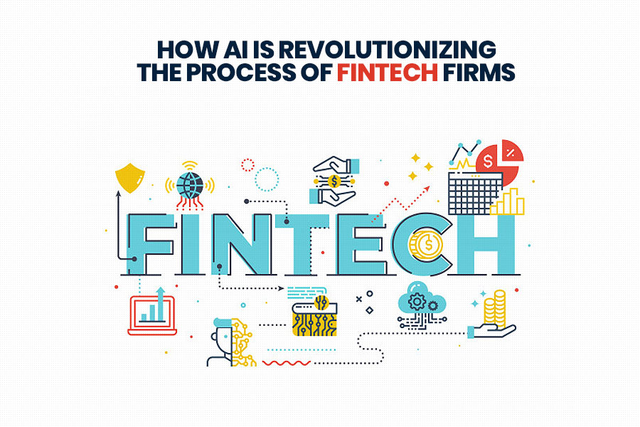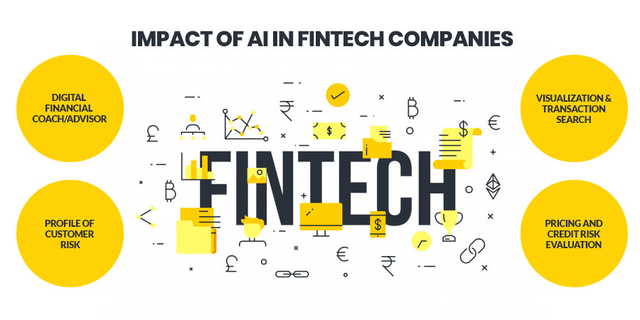
How AI is Revolutionizing the Process of Fintech Firms?
Last Updated on July 20, 2023 by Editorial Team
Author(s): Kristy Hill
Originally published on Towards AI.
AI is expanding the development of Fintech Companies and taking care of human issues, by increasing efficiency.

Artificial Intelligence has revolutionized the finance industry. Not only does it improve the precision level in the industry, but it also enhances the customer engagement level and speed up the query resolution period. In this blog, we will be finding out answers about the importance of AI in financial sectors or FinTech firms. So, let’s start.
By the year 2030, traditional financial institutions can shave 22% in costs, as per the latest 84-page report of the Autonomous in an AI in the financial industry.
Fintech companies and financial firms were the early adopters of relational databases, mainframe computers, and have eagerly awaited the next generation of computational and analysis power. AI helps Fintech companies in resolving human problems, by enhancing efficiency. AI improves results by applying various methods derived from the various aspects of Human Intelligence at a beyond human scale.
The computational arms race of the last 2 decades has revolutionized the FinTech companies. Various latest technologies like Artificial Intelligence (AI), Machine Learning, Neural Networks, evolutionary algorithms, Big Data Analytics, and much more have allowed computers to crunch varied, diverse and deep datasets than ever before.
A customer-centric approach, cost optimization, enhanced security, and real-time data integration are the crucial needs of the current financial sector that mimic the business dynamics of the FinTech firms.
The word FinTech is synonymous with comfort, innovation, and high access to the financial world. The Artificial Intelligence majority of FinTechs aims at financial inclusion which allows the audience to benefit from the overall financial system.
As artificial intelligence has emerged in the financial industry, the complications and barriers people have become accustomed to seeking the advantage of MFI financial services and banking do not exist today. There are many AI development companies focusing on creating AI-based financial solutions.
In addition to this, thanks to the new generation of technology-oriented financial institutions and artificial intelligence technology, which has enabled the target audience to use easy and cost-effective financial solutions.
Now whether you need a customer to borrow loans or invest money in profitable options, various FinTech firms have the solutions for all their requirements. In addition to this, the only thing to remember here is that no company can offer cost-effective solutions on the market unless they have the advantage of reducing operating costs.
Moreover, FinTechs can provide its customers with quality services at relatively lower costs, as AI allows them to control costs at every stage. In addition, greater human-machine compatibility allows them to offer high-quality solutions with a small workforce.
Banking sector
The use of modern technologies in NBFCs and banks allows them to develop products that offer customers more at lower prices. In the past, product options were limited, and this was followed by strict policies that make the customer dissatisfied and annoyed with the banking system. Now financial institutions have a better understanding of clients and offer or recommend choices based on their actual requirements and needs.
Artificial intelligence has simplified banking and financial operations using a number of algorithms. In addition to this, FinTechs scoring algorithms help you get complete information about each one. On the other hand, the reverse predictive analysis highlights every opportunity and helps the customer in choosing the right product or service. Moreover, all of this information can be accessed online on FinTech websites and mobile apps.

FinTech and Artificial intelligence

The benefits of using artificial intelligence in financial services and FinTech corporate operations are frequent and extensive. In addition to this, from marketing your products and services to customer research, Artificial Intelligence, combined with big data and predictive analytics, is very effective in increasing the reach and scope of financial institutions worldwide.
Now, the entire loan process takes only a few hours, and if one applies for a loan in the morning, the loan funds are paid off on the same date. In addition to this, with the entry of Amnesty International in the multifaceted financial sector, both accuracy and speed increased.
Adaptation to the latest technology is a daily necessity, but the key to a successful business is to deliver services or products as per the market needs. As a result, FinTech firms are tailoring themselves to the needs of evolving markets. In addition to this, they work hard to create a more customer-friendly financial environment by eliminating any complexity in the documentation and delivering products.
Some recent stats shows that, bringing artificial intelligence on board cut losses by 23% annually.
Unlike traditional banking firms, which still stick to long paper designs, FinTechs is growing fast with optimal use of big data, artificial intelligence, and predictive intelligence. And, software development companies are already using the features of these latest technologies to create unique and feature-packed FinTech applications. In addition to this, these latest technologies have become an integral part of FinTech firms and their role is not only to develop customized business solutions but also to play a key role in protecting customer personal information and ensuring the security of FinTech’s financial assets.
Let’s have a look at some examples of the impact of AI in Fintech companies:

1. Digital Financial Coach/Advisor
Business robots are one of the most common use cases of artificial intelligence, possibly owing to a wide array of applications — across all sectors, across different levels. In the finance domain, transaction robots can also be used in order to provide financial advisory or various other advisory services to users.
Think of them as digital assistants who help their users navigate savings, financial plans, and spending. This particular service enhances user engagement and also improves the overall user experience with any financial product that they interact with.
In addition to this, digital assistants can be created with Natural Language Processing, which is a type of machine learning model that can process data or information in a human language format. In addition to this, the Product Recommendation Form layer can also be added, allowing the assistant to recommend products or services based on the latest transactions between the algorithm and the human being.
A famous example of this mobile app was created by Sun Life, who created a virtual assistant named Ella in order to help benefit users who retire and retire by staying on top of the insurance plans. Moreover, the assistant sends reminders to users based on user information like “Your child will benefit soon” or “Healthcare benefits are about to expire”.
Furthermore, digital assistants can also be used in various other financial scenarios: managing dividends, approaching any transaction limit, extending maturity, or verifying notifications.
2. Visualization & Transaction search
Managers at financial institutions give access to user transaction (banking) data for bots and use NLP in order to determine the meaning of the sending user request (search query). In addition to this, these requests can be related to balance requests, general account information, spending habits, and more. The robot handles all kinds of requests and displays the results.
For instance, Bank of America uses this type of automated software (called Erica) as a digital financial assistant for its customer base. Furthermore, the AI-powered robot was quickly certified — one million users in three months.
In addition to this, the bot program provides an easy-to-use transaction search, allowing users to search for specific financial transactions with a specific merchant in their historical data while avoiding the hassles of searching every bank account statement. In addition to this, the bot also calculates the total amount of credit and debt — a task that users had to do with their calculators.
3. Profile of customer risk
An important part of the work of banks and insurance companies is to define customer profiles based on their level of risk. Artificial Intelligence is a great tool for this type of task because it can automate customer rankings based on their risk data from low to high.
In addition to this, depending on the classification business, consultants may decide to link financial products to each risk profile and automatically present them to clients (product recommendations). In this mobile app, classification models, such as XGBoost or Artificial Neural Network (ANN), are trained in historical client data and pre-labelling data provided by the consultant to prevent data deviation.
4. Pricing and credit risk evaluation
Insurance firms offer underwriting services, especially for investments and loans. The AI-powered model can provide an immediate assessment of a customer’s credit risk, allowing consultants to design the most relevant offer. In addition to this, the uses of artificial intelligence to sign up services increase the efficiency of offers and improves customer experience as it speeds up the process and turnaround time for such activities.
Manulife, the financial services group based in Canada, is the first player to use AI for its underwriting services, making many Canadians quicker to purchase basic life insurance, and is the key to closing Canada’s protection gap.
In addition to this, the insurance firms employ the Artificial Intelligence Decision Algorithm (AIDA), a private organization, trained in past underwriting techniques and costs, and it can have various classification processes such as compensation or high losses. This method is not used in insurance; it can also be used to evaluate loans for loans.
Let’s Wrap Up:
No doubt, AI is powering the financial institutions like never before. Now more and more financial and banking institutions are embracing the features of artificial intelligence to make their process more precise and prompt. If you also want to have your own FinTech solution, then you hire an offshore software development company. There are many software development companies where you can hire software developer for your financial project.
Join thousands of data leaders on the AI newsletter. Join over 80,000 subscribers and keep up to date with the latest developments in AI. From research to projects and ideas. If you are building an AI startup, an AI-related product, or a service, we invite you to consider becoming a sponsor.
Published via Towards AI
Take our 90+ lesson From Beginner to Advanced LLM Developer Certification: From choosing a project to deploying a working product this is the most comprehensive and practical LLM course out there!
Towards AI has published Building LLMs for Production—our 470+ page guide to mastering LLMs with practical projects and expert insights!

Discover Your Dream AI Career at Towards AI Jobs
Towards AI has built a jobs board tailored specifically to Machine Learning and Data Science Jobs and Skills. Our software searches for live AI jobs each hour, labels and categorises them and makes them easily searchable. Explore over 40,000 live jobs today with Towards AI Jobs!
Note: Content contains the views of the contributing authors and not Towards AI.














